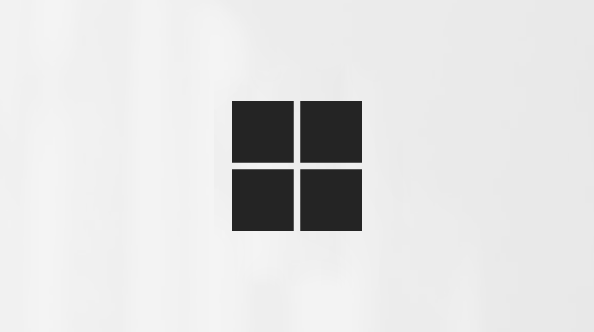This article is for people who use a screen reader program such as Windows Narrator, JAWS, or NVDA with Windows tools or features and Microsoft 365 products. This article is part of the Accessibility help & learning content set where you can find more accessibility information on our apps. For general help, visit Microsoft Support.
Use Excel with your keyboard and a screen reader to organize data into a table for faster analysis. We have tested it with Narrator, JAWS, and NVDA, but it might work with other screen readers as long as they follow common accessibility standards and techniques. You'll learn how to create a table, add rows and columns to a table, and delete rows and columns from a table.
Notes:
-
New Microsoft 365 features are released gradually to Microsoft 365 subscribers, so your app might not have these features yet. To learn how you can get new features faster, join the Office Insider program.
-
To learn more about screen readers, go to How screen readers work with Microsoft 365.
In this topic
Create a table
-
On a worksheet, select the cells that you want to include in the table. The cells can be empty or can contain data.
-
Press Ctrl+T (or Ctrl+L). The Create Table dialog box opens and you hear: "Create table."
-
Press the Tab key until you hear "My table has headers," and then do one of the following:
Note: Table headers are very important for accessibility. Screen readers use the information in the headers for navigation, and meaningful column headings can help readers understand the data.
-
If the selected range of cells contains data that you want to display as table headers, press Spacebar to select the checkbox.
-
If you want to use the default names Excel provides (for example, Column 1, Column 2, and so on), do not select the checkbox.
Tip: You can always change the default column names later by selecting the text in a column header and typing the name you want.
-
-
To close the Create Table dialog box and return to the worksheet, press the Tab key until you hear "OK," and then press Enter.
Keyboard shortcuts for tables
Here is a handy reference for keyboard shortcuts that apply to tables in Excel.
|
To do this |
Press |
|---|---|
|
Create a table in default style |
Ctrl+T or Ctrl+L |
|
Create a table by selecting a style from the Format as Table menu |
Alt+H, T |
|
Insert a row above |
Alt+H, I, A |
|
Insert a column to the left |
Alt+H, I, L |
|
Delete a row or rows |
Alt+H, D, L |
|
Delete a column or columns |
Alt+H, D, M |
|
Open the Table Design tab |
Alt+J, T |
|
Create or remove table headers |
Alt+J, T, O |
|
Open the context menu |
Shift+F10 or Windows Menu key |
Add a row or column to a table
-
Navigate to the location where you want to add a new row or column.
-
Press Alt+H, I. The Insert menu opens and you hear: "Insert cells."
-
Do one of the following:
-
To insert a row above, press A.
-
To insert a row below, press B. This option is only available if you are on the last row in the table.
-
To insert a column to the left, press L.
-
To insert a column to the right, press T. This option is only available if you are on the last column in the table.
-
Delete a row or column from a table
-
Navigate to the row or column that you want to delete.
-
Press Alt+H, D. The Delete menu opens and you hear: "Delete cells."
-
Do one of the following:
-
To delete the current row, press L.
-
To delete the current column, press M.
-
See also
Use a screen reader to sort or filter a table in Excel
Basic tasks using a screen reader with Excel
Set up your device to work with accessibility in Microsoft 365
Use Excel for Mac with your keyboard and VoiceOver, the built-in macOS screen reader, to organize data into a table for faster analysis.
Notes:
-
New Microsoft 365 features are released gradually to Microsoft 365 subscribers, so your app might not have these features yet. To learn how you can get new features faster, join the Office Insider program.
-
This topic assumes that you are using the built-in macOS screen reader, VoiceOver. To learn more about using VoiceOver, go to VoiceOver Getting Started Guide.
In this topic
Create a table
When you have a worksheet with some data, it's easy to turn the cells into a table.
-
In your worksheet, select the cells that you want to include in the table. To select cells, use the arrow keys to navigate to the cell you want to be the upper-left corner of the table, hold down Shift, and then use the Down and Right arrow keys to select more rows and columns. VoiceOver announces the range of selected cells after each key press, for example, "A1 to C2, selected."
Tip: If you want to quickly select all cells that contain data, press Command+A when you are in one of the cells containing the data.
-
Press Command+T. You hear: “Create table.”
-
Press the Tab key until you hear "My table has headers, unchecked checkbox," and then do one of the following:
-
If the selected range of cells contains data that you want to display as table headers, press Spacebar to select the checkbox.
-
If you want to use the default names Excel provides (for example, Column 1, Column 2, and so on), do not select the checkbox. Press Spacebar to clear the option if it's selected.
Note: Table headers are very important for accessibility. Screen readers use the information in the headers for navigation, and meaningful column headings can help readers understand the data.
-
-
To close the Create Table dialog box and return the focus to the worksheet, press the Tab key until you hear "OK, default, button," and press Return.
Add a row or column to a table
-
In your table, navigate to the location where you want to add a new row or column.
-
Press F6 until you hear the name of the currently selected tab, for example, "Home, selected, tab." If you are not on the Home tab, press Control+Option+Left arrow key until you hear "Home, tab," and press Control+Option+Spacebar to select the tab.
-
Press the Tab key until you hear "Insert, menu button," and then press the Down arrow key to open the menu.
-
Do one of the following:
-
To insert a row above the current row, press the Tab key until you hear "Insert table rows above," and then press Control+Option+Spacebar.
-
To insert a row below the current row, press the Tab key until you hear "Insert table row below," and then press Control+Option+Spacebar. This option is only available if you are on the last row in the table.
-
To insert a column to the left of the current column, press the Tab key until you hear "Insert table columns to the left," and then press Control+Option+Spacebar.
-
To insert a column to the right of the current column, press the Tab key until you hear "Insert table columns to the right," and then press Control+Option+Spacebar. This option is only available if you are on the last column in the table.
-
See also
Use a screen reader to sort or filter a table in Excel
Basic tasks using a screen reader with Excel
Set up your device to work with accessibility in Microsoft 365
Use Excel for Android with TalkBack, the built-in Android screen reader, to insert and modify a table in your workbook. Make your tables more accessible by adding alternative text to the table. You can also expand the tables by adding new rows and columns, or you can show your data as a chart.
Notes:
-
New Microsoft 365 features are released gradually to Microsoft 365 subscribers, so your app might not have these features yet. To learn how you can get new features faster, join the Office Insider program.
-
This topic assumes that you are using the built-in Android screen reader, TalkBack. To learn more about using TalkBack, go to Android accessibility.
In this topic
Insert a table
Add a table to present your data in an effective and systematic way. You can insert a table on a blank worksheet and fill in your data. Alternatively, you can quickly create a table by using data in your existing cell cluster.
-
To move to a cell where you want to insert a table, drag one finger across the screen until you hear the cell you want. If you want to turn existing data in your cells into a table, simply go to one of the cells in the cell cluster. Then double-tap the screen.
-
Drag one finger around the lower-right corner of the screen until you hear "Off, More options switch," and double-tap the screen. You hear "Tab menu," followed by the currently selected tab, for example, "Home, selected.”
-
Double-tap the screen. The tab menu opens. Swipe right or left until you hear “Insert tab," and double-tap the screen.
-
Swipe right until you hear “Table, button,” and then double-tap the screen. You hear: “Not checked, Table has headers, checkbox.”
-
Do one of the following:
-
If your table has data that you want to display as table headers, swipe left until you hear: "Not checked, Table has headers, checkbox, double-tap to toggle." Then double-tap the screen. You hear: "Checked."
-
If you want to use the default names Excel provides (for example, Column1, Column2, and so on), do not select the checkbox and proceed to the next step.
Note: Table headers are very important for accessibility. Screen readers use the information in the headers for navigation, and meaningful column headings can help readers understand the data.
-
-
To move away from the checkbox, tap anywhere on the screen with two fingers.
The table is now added to your worksheet.
Add an alternative text to a table
To make your tables in Excel accessible for a wider audience, add a short and descriptive alt text to it.
-
In your worksheet, slide one finger across the screen until you hear "Entering table," followed by the table and cell details, and then double-tap the screen. The focus can be anywhere in the table.
-
Drag one finger around the lower-right corner of the screen until you hear "Off, More options switch," and double-tap the screen. You hear "Tab menu," followed by the currently selected tab, for example, "Home, selected."
-
Double-tap the screen. The tab menu opens. Swipe right or left until you hear “Table tab," and double-tap the screen.
-
Swipe right until you hear “Alt text, menu,” and double-tap the screen. You hear: "Alt text."
-
Swipe right until you hear: “Edit-box for, describe this object for someone who is blind.” Then double-tap the screen.
-
Use the on-screen keyboard to type a short alt text for your table. To close the keyboard, swipe down-then-left.
-
To return to the Table tab menu, swipe down-then-left.
Add a row or a column to a table
You can easily expand your table by adding more rows or columns to it.
-
In your worksheet, slide one finger across the screen until you hear "Entering table," followed by the table and cell details.
-
Swipe left or right until you hear the location where you want to add a new row or a column, and then double-tap the screen.
-
Drag one finger around the lower-right corner of the screen until you hear "Off, More options switch," and double-tap the screen. You hear "Tab menu," followed by the currently selected tab, for example, "Home, selected.”
-
Double-tap the screen. The tab menu opens. Swipe right or left until you hear “Table tab," and double-tap the screen.
-
Do one of the following:
-
To insert a row above the current location, swipe right or left until you hear "Insert above, button," and then double-tap the screen.
-
To insert a row below the current location, swipe right or left until you hear "Insert below, button," and then double-tap the screen.
-
To insert a column to the left of the current location, swipe right or left until you hear "Insert left, button," and then double-tap the screen.
-
To insert a column to the right of the current location, swipe right or left until you hear "Insert right, button," and then double-tap the screen.
-
Delete a row or a column from a table
You can quickly delete unnecessary rows or columns from your table.
-
In your worksheet, slide one finger across the screen until you hear "Entering table," followed by the table and cell details.
-
Swipe left or right until you hear the row or column you want to delete.
-
Drag one finger around the lower-right corner of the screen until you hear "Off, More options switch," and double-tap the screen. You hear "Tab menu," followed by the currently selected tab, for example, "Home, selected.”
-
Double-tap the screen. The tab menu opens. Swipe right or left until you hear “Table tab," and double-tap the screen.
-
Swipe right until you hear “Delete rows, button” or “Delete columns, button,” and then double-tap the screen.
Apply formatting to your table
You can select a predefined style for your table.
-
In your worksheet, slide one finger across the screen until you hear "Entering table," followed by the table and cell details.
-
Drag one finger around the lower-right corner of the screen until you hear "Off, More options switch," and double-tap the screen. You hear "Tab menu," followed by the currently selected tab, for example, "Home, selected.”
-
Double-tap the screen. The tab menu opens. Swipe right or left until you hear “Table tab," and double-tap the screen.
-
Swipe right until you hear “Table styles, menu,” and then double-tap the screen. You hear: “Table styles.”
-
Swipe right or left until you hear a style you want. The styles are organized into three categories: Light, Medium, and Dark. To select a style, double-tap the screen.
Show your data in a chart
You can show the data in your table in chart format.
-
In your worksheet, slide one finger across the screen until you hear "Entering table," followed by the table and cell details.
-
Drag one finger around the lower-right corner of the screen until you hear "Off, More options switch," and double-tap the screen. You hear "Tab menu," followed by the currently selected tab, for example, "Home, selected."
-
Double-tap the screen. The tab menu opens. Swipe right or left until you hear “Insert tab," and double-tap the screen.
-
Swipe left or right until you hear: “Chart menu.” Double-tap the screen. You hear: “Chart.”
-
Swipe left or right until you hear the chart type you want to select, for example, "Pie, menu." Double-tap the screen. You hear the name of the selected chart type, for example, "Pie." The chart type list opens.
-
In the chart type list, swipe right or left to browse through the list. You hear the list item names, for example, “3D pie, list item.” To select a chart type, double-tap the screen.
The chart is generated on the worksheet.
See also
Use a screen reader to sort or filter a table in Excel
Basic tasks using a screen reader with Excel
Set up your device to work with accessibility in Microsoft 365
Use Excel for the web with your keyboard and a screen reader to organize data into a table for faster analysis. We have tested it with Narrator in Microsoft Edge and JAWS and NVDA in Chrome, but it might work with other screen readers and web browsers as long as they follow common accessibility standards and techniques. Tables allow you to easily filter data and calculate totals.
Notes:
-
If you use Narrator with the Windows 10 Fall Creators Update, you have to turn off scan mode in order to edit documents, spreadsheets, or presentations with Microsoft 365 for the web. For more information, refer to Turn off virtual or browse mode in screen readers in Windows 10 Fall Creators Update.
-
New Microsoft 365 features are released gradually to Microsoft 365 subscribers, so your app might not have these features yet. To learn how you can get new features faster, join the Office Insider program.
-
To learn more about screen readers, go to How screen readers work with Microsoft 365.
-
When you use Excel for the web, we recommend that you use Microsoft Edge as your web browser. Because Excel for the web runs in your web browser, the keyboard shortcuts are different from those in the desktop program. For example, you’ll use Ctrl+F6 instead of F6 for jumping in and out of the commands. Also, common shortcuts like F1 (Help) and Ctrl+O (Open) apply to the web browser – not Excel for the web.
-
When you use Excel for the web with a screen reader, switch to the full screen mode. Press F11 to toggle the full screen mode on and off.
In this topic
Create a table
-
In Excel for the web, select the cells that you want to include in the table. The cells can be empty or can contain data.
-
Press Ctrl+L to open the Create Table dialog box. You hear: "Create table."
-
Press Shift+Tab until you hear "My table has headers, checkbox unchecked," and then do one of the following:
-
If the selected range of cells contains data that you want to display as table headers, press Spacebar to select the My table has headers checkbox.
-
If you want to use the default names Excel provides (for example, Column1, Column2, and so on), do not select the checkbox and proceed to the next step.
Note: Table headers are very important for accessibility. Screen readers use the information in the headers for navigation, and meaningful column headings can help readers understand the data.
-
-
Press the Tab key until you hear "OK, button," and then press Enter.
-
You can now enter your data to the table. To enter or replace data in a cell, move to the cell you want and type the text, number, or formula.
Tip: To learn more about adding or editing your data, refer to Basic tasks using a screen reader with Excel.
Add a row or column to a table
-
Navigate to the row above which you want to add a new row or to the column to the left of which you want to add a new column.
-
Press Alt+Windows logo key, H, and then I. The Insert menu opens and you hear: "Insert copied cells."
-
Do one of the following:
-
To insert a row above, press A.
-
To insert a column to the left, press L.
-
Delete a row or column from a table
-
Navigate to the row or column that you want to delete.
-
Press Alt+Windows logo key, H, and then D. The Delete menu opens and you hear: "Delete Sheet Rows."
-
Do one of the following:
-
To delete the current row, press L.
-
To delete the current column, press M.
-
See also
Use a screen reader to sort or filter a table in Excel
Use a screen reader to find and replace data in Excel
Technical support for customers with disabilities
Microsoft wants to provide the best possible experience for all our customers. If you have a disability or questions related to accessibility, please contact the Microsoft Disability Answer Desk for technical assistance. The Disability Answer Desk support team is trained in using many popular assistive technologies and can offer assistance in English, Spanish, French, and American Sign Language. Please go to the Microsoft Disability Answer Desk site to find out the contact details for your region.
If you are a government, commercial, or enterprise user, please contact the enterprise Disability Answer Desk.











